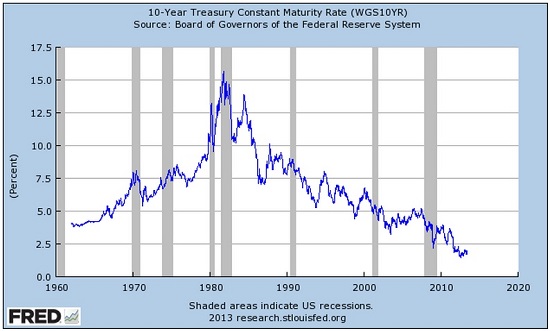Courtesy of Charles Hugh-Smith of OfTwoMinds
I see #1 and #4 as the most likely triggers of a rise in Treasury yields.

Correspondent Mark G. recently asked a question that is on many minds: what might finally produce an end to the 34-year US Treasury Bond bull market? Here is Mark's commentary on the question:
10 Year T-Bond interest rates are falling again after a minor rally. This leaves me pondering a nearly 20-year old question: what might finally produce an end to the 34-year US Treasury Bond bull market? Neither the beginning or end of three different US QE programs, plus Japanese and ECB QE programs, have served to do this. Nor did oil price booms to $140/bbl, or price crashes to $42/bbl WTI with threats of further decline. Or any other commodity or possible index of commodities. Various FOREX levels so far have also been only correlated over the very shortest of terms. Stock market bull bubbles and bear crashes have also come and gone without lasting effect. War, peace, Cold War, Cold Peace ditto.
My background education and experience says that before this T-Bond bull market can end the US T-Bond sellers will have to routinely overwhelm the buyers.
1. The Federal Reserve (the central bank of the U.S.) would have to be restrained from printing money to buy Treasuries. This could be informal political constraints (i.e. widespread public distrust of the Fed based on its role in exacerbating wealth inequality) or it could be the Federal Reserve's charter and powers are limited by acts of a Congress that is hostile to its counter-productive money-printing and financial repression.2. The supply (issuance) of new bonds rises to levels that overwhelm demand. Were the U.S. government to run enormous deficits, the supply might well overwhelm demand, especially if the Fed were no longer free to print up another $3 trillion to buy bonds.3. Other sovereign-debt markets that are currently being sold in favor of U,S. Treasuries would have to become more attractive in yield, liquidity and safety than Treasuries. Right now, oligarchs around the world have already suffered losses of 15% to 25% on their wealth not held in U.S. dollars.The rush to sell other currencies and assets to buy dollars and Treasuries has enabled the Fed to end its quantitative easing/bond buying programs; the demand from overseas buyers has been strong enough to push yields down to historic lows, even without any Fed purchases.This trend would have to reverse for Treasuries to be sold in favor of some other sovereign bonds.4. The phantom wealth in risk-on assets would have to dissolve on a global scale, forcing owners of unleveraged assets such as Treasuries to dump their Treasuries en masse to raise cash to pay down U.S.-denominated debt and to to fund their lavish lifestyles.Once the markets for yachts, super-sports cars, etc., dry up, these assets go bidless: nobody wants a costly-to-maintain yacht or super-car at any price. Real estate may retain more of its value than oligarch toys, but real estate is famously illiquid; the margin call must be paid in days, and finding a buyer for luxe real estate takes longer than days.That leaves precious metals and the amazingly liquid Treasury bonds as assets that can be sold in a hurry to cover debts being called due to the collapse of risk-on bubbles in equities, junk bonds, real estate, art, yachts, super-cars, etc.



